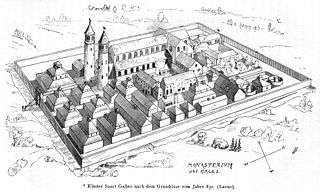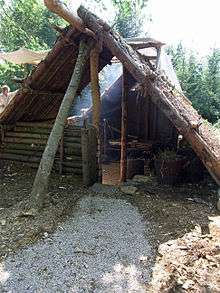Campus Galli
Campus Galli is a Carolingian monastic community under construction in Meßkirch, Baden-Württemberg, Germany. The construction project includes plans to build a medieval monastery according to the early ninth-century Plan of Saint Gall using techniques from that era. The long-term financing of the project is to come from revenue generated from the site's operation as a tourist attraction. The construction site has been open for visitors since June 2013.[2]
| Campus Galli | |
|---|---|
Carpenter's hut at Campus Galli | |
 Campus Galli in Germany | |
| General information | |
| Coordinates | 48.033533°N 9.108905°E |
| Construction started | 2013 |

Construction site

The Carolingian monastery town is being constructed in a wooded area approximately four kilometers north of the small town of Meßkirch in southern Germany. The buildings are being built according to the Plan of Saint Gall, which is the only surviving major architectural drawing from the middle-ages. The construction of the monastery town will be accomplished as much as possible with the materials and methods of the time of Charlemagne in keeping with goals of experimental archaeology,[3] thereby increasing our scientific knowledge of Carolingian architecture and engineering. The major raw materials, such as wood and stone, will be obtained from the site.
Between 20 and 30 staff members will be permanently at the site, with an exception according to the Medieval custom for resting during the winter months from 11 November (St. Martin's day) until 2 April (Charlemagne's birthday). The total construction time is estimated at forty years. Volunteer workers not only help with the construction, but also act as costumed interpreters.[4]
The project was launched by the Aachen-based journalist Bert Geurten with 1 million euros provided by city, state and European-Union sources.[5] An Advisory Board of 18 experts in fields including archaeology, history, theology, and veterinary medicine will provide the scientific management and monitoring of the construction.[6]
Construction progress
A small area in the forest was cleared by the end of June 2013, and temporary shelters for the craftsmen were built.[7] A map of the site shows areas for carpenters, basket weavers, potters, blacksmiths, stonemasons, wood turners, broom makers, roofers, textile workers, and rope makers.[8] There are also pens for pigs, goats and sheep, and a chicken coop, along with a bee hive. There is a herb garden for healer's plants. In the center of the site is the ongoing construction of a wooden church.
Wooden church
The construction of a wooden church was started in 2014, and the main structure was completed in 2015. Construction continues on the interior and details of the exterior.[9]
 July 2016
July 2016 April 2017
April 2017
Scholarly Research
On 20 April 2018, the Campus Galli was officially named 'teaching and research site of the University of Tübingen'.[10] The production of ceramics and also the production and processing of mortars using medieval methods at Campus Galli are of interest to the Competence Center Archaeometry Baden-Wuerttemberg (CCA-BW). Mineralogical investigations can establish the connection between archaeological finds and materials produced according to traditional methods. Archaeological experiments on ceramic firing and joint courses for students of archaeology will also be conducted as part of the cooperation.
See also
- Duncarron is the reconstruction of a typical residence of a scottish Clan Chief from the early part of the last millennium.
- Guédelon Castle in France, a project for an authentic construction of a medieval castle in Treigny
References
- J. Rudolf Rahn, Geschichte der Bildenden Künste in der Schweiz. Von den Ältesten Zeiten bis zum Schlusse des Mittelalters. Zürich 1876.
- Campus Galli - karolingische Klosterstadt Meßkirch "Herzlich willkommen bei Campus Galli - karolingische Klosterstadt" (in German).
- EXARC, "Campus Galli" Archived 24 November 2016 at the Wayback Machine, EXARC is the ICOM Affiliated Organisation representing archaeological open-air museums, experimental archaeology, ancient technology and interpretation.
- Andreas Sturm, Sybille A. Beyer: Building the Plan of Saint Gall. A Living History Enterprise Back to the Roots of European Culture, Lecture at the conference "Staging the Past - Themed Environments ini Transcultural Perspective" University of Freiburg, Germany, 25 April 2009. Archived 2011-09-19 at the Wayback Machine
- Angelika Franz, "Ox Carts and No Coffee: Building a Monastery the Medieval Way", Spiegel Online International, 21 March 2012.
- Andreas Sturm, "Konzeptionelle Mängel in der Umsetzung des Projektes „Campus Galli – karolingische klosterstadt messkirch", 26 March 2013 (in German).
- "So schufteten sie im Reich Karls des Großen", Die Welt, 24 June 2013 (in German).
- "Site map of Campus Galli", Karolingische Klosterstadt Meßkirch, (in German).
- Selina Ehrenfeld, "Mehr als 65000 besuchen Campus Galli", Schwäbische Zeitung, 3 November 2016 (in German).
- "Competence Center Archaeometry Baden-Wuerttemberg", University of Tübingen, 21 April 2019.
External links
| Wikimedia Commons has media related to Campus Galli. |
- Campus Galli, official website in English
- City of Meßkirch